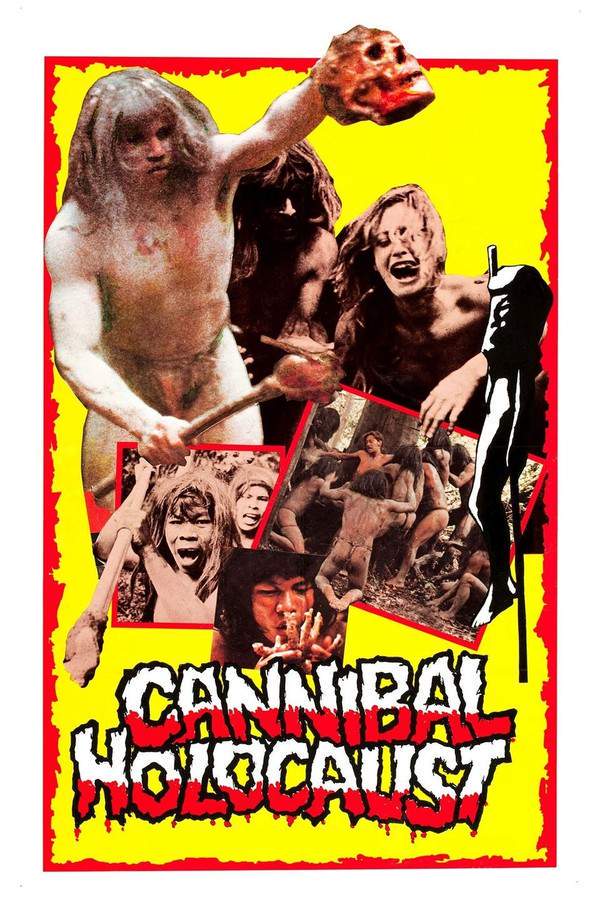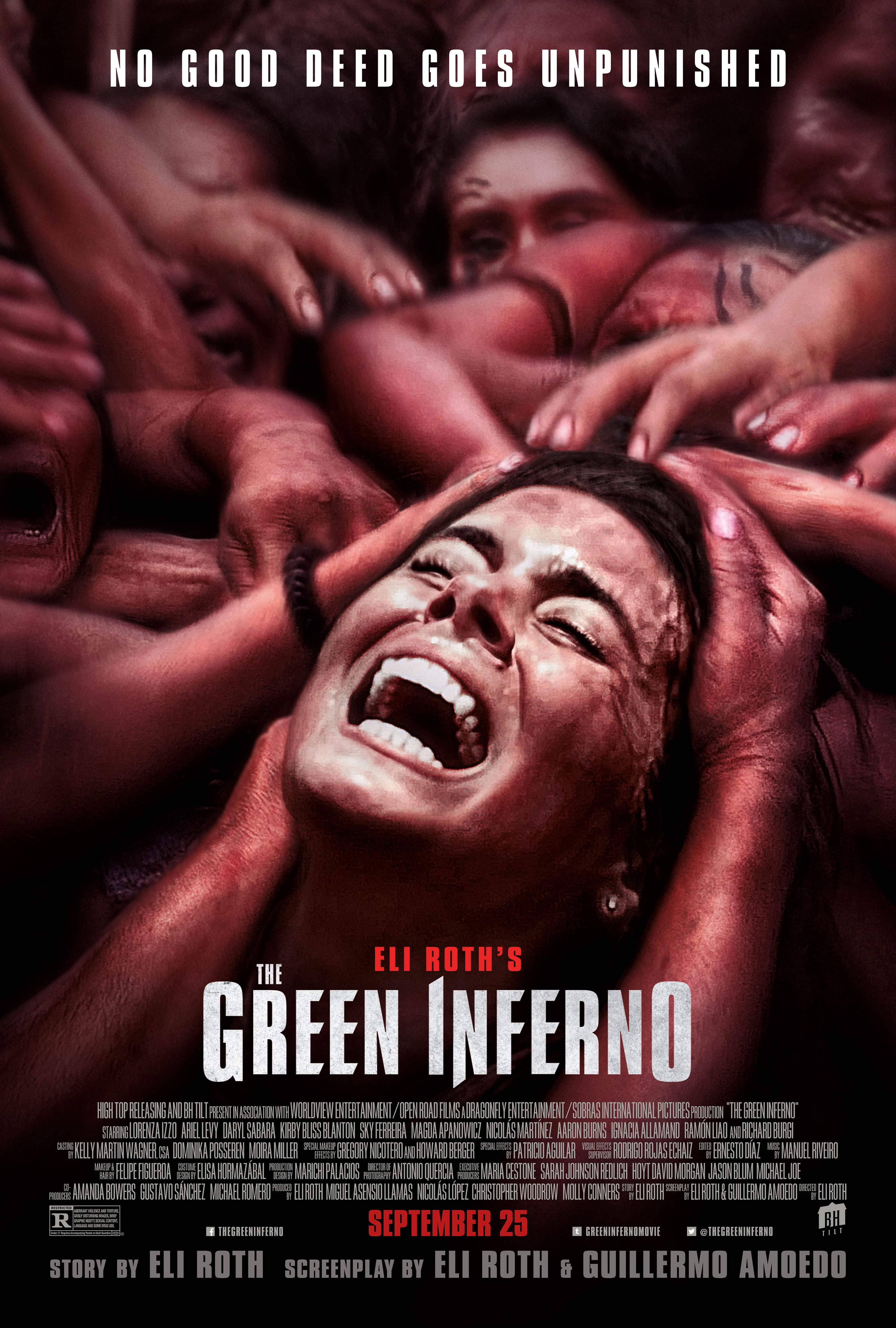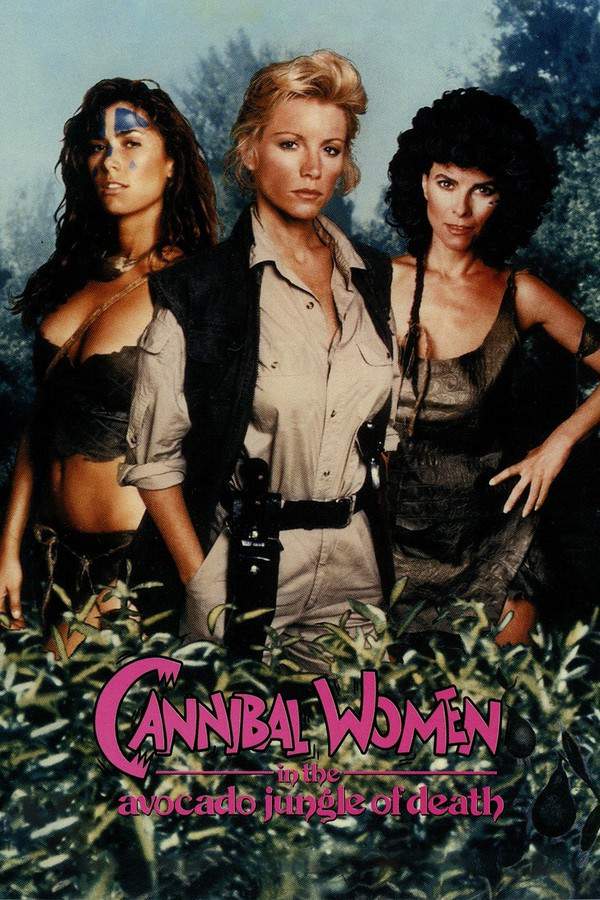
Cannibal Holocaust 1980
Directed by

Ruggero Deodato
Made by

United Artists Europa
Test your knowledge of Cannibal Holocaust with our quiz!
Cannibal Holocaust Plot Summary
Read the complete plot summary and ending explained for Cannibal Holocaust (1980). From turning points to emotional moments, uncover what really happened and why it matters.
In New York City, a television news reporter delves into the perplexing case of a documentary film crew that vanished without a trace in the dense jungles of South America two months prior. The crew is led by Alan Yates, the ambitious director, accompanied by his girlfriend and script girl, Faye Daniels, along with cameramen Jack Anders and Mark Tomaso. Their last known location was the isolated town of Leticia, situated in the heart of the jungle, where they aimed to document the existence of local cannibal tribes. As part of an investigative effort, Professor Harold Monroe from NYU is tasked with uncovering the mystery surrounding the incautious film crew’s disappearance.
As the story unfolds in the South American jungles, a patrol led by a balding Negro lieutenant stumbles upon a shocking scene of cannibalism being practiced by local natives, culminating in a violent confrontation that leaves several natives dead. Following the chaos, Monroe meets the lieutenant, who presents a captured native linked to the Yacumo tribe, marked with a tattoo indicating significant heritage. A cigarette lighter found on him confirms the connection to Faye. Monroe teams up with Chaco, a Venezuelan guide, who provides insight into the local customs, revealing that the Yacumo are believed to be engaged in a spiritual ceremony rather than acts of cannibalism.
Monroe, accompanied by Chaco and another young guide named Miguel, embarks on a perilous journey deeper into the jungle, where they uncover signs of the missing filmmakers. Among the gruesome discoveries, they find the remains of Felipe, the Yates team’s guide, and witness a barbarous ritual involving a Yacumo man and his wife. Finding the Yacumo village, they cautiously earn the trust of the wary tribe members.
As they journey on, Monroe aims to reach the dreaded Yamamomo tribe, known as the Tree People, who are disconnected from the modern world and embroiled in perpetual conflict with the Shamatari, referred to as Swamp People. In a tense moment, Monroe and his guides manage to foster an alliance with the Yamamomo by leapfrogging into a confrontation against the hostile Shamatari warriors. However, their welcome remains fraught with suspicion. They teach Monroe some of the tribe’s customs to build rapport.
The following day, a moment of bonding occurs as Monroe engages in activities with the Yamamomo women, which gains him their favor. Ultimately, Monroe and his guides come upon a disturbing totem shrine with the skeletal remains of the Yates team, revealing the grim fate of the crew. The sight of their intact film equipment heightens Monroe’s urgency to recover their recordings.
Weeks later back in New York, Monroe is interviewed about the jungles’ dark secrets and the Yates crew’s tragic end. He sits to view the troubling footage from the lost film crew under the oppressive scrutiny of university board executives who wish to sensationalize the material for television audiences. They are treated to shocking glimpses of the film team’s arrogant ventures into the wild, revealing a string of morally atrocious acts committed against both nature and the indigenous tribes they sought to engage.
As the chilling imagery unfolds, Monroe grows increasingly horrified. He discovers how Yates and his crew, driven by a self-serving quest for fame, perpetrated brutal violence against the Yacumo and destroyed their village. In a particularly grotesque segment, they record the impact of their brutality, showcasing their misguided views as they continue filming without remorse.
Monroe pleads with the executives, arguing against airing the film, reframing it as an exploitation of their victims and calling it “offensive, dishonest, and inhuman”. In the final reel, an image surfaces revealing the crew’s vile demise as they encounter the Yamamomo. A young woman becomes their target, and as both filmmakers and indigenous tribes clash, it becomes clear that the fate of the heedless Yates crew is much darker than anyone could have anticipated.
As the viewing comes to a close, the executives are left aghast. After a moment of reflection, they acquiesce to Monroe’s perspective, agreeing to bury the footage. Stepping back into the urban landscape of New York, Monroe questions the nature of civilization and primal instincts, whispering to himself, “I wonder who the real cannibals are.”
Cannibal Holocaust Timeline
Follow the complete movie timeline of Cannibal Holocaust (1980) with every major event in chronological order. Great for understanding complex plots and story progression.
The Disappearance of the Film Crew
Two months prior to the investigation, a documentary film crew led by Alan Yates vanished in the dense jungles of South America. Their aim was to document the existence of local cannibal tribes, venturing into treacherous territory without adequate preparation.
The Investigation Begins
In New York City, television news reporter uncovers the mysterious case of the vanished crew. With the guidance of NYU Professor Harold Monroe, an investigation team is formed to delve deeper into the jungle's ominous tale.
Arrival in Leticia
Monroe and his team arrive in the isolated town of Leticia, where they seek information about the last known whereabouts of the film crew. The local atmosphere filled with danger sets the stage for their perilous journey ahead.
Cannibalism Discovery
While exploring a jungle area, a patrol discovers a horrific scene of cannibalism. The violent encounter with the locals escalates, leading to a confrontation that leaves several natives dead.
Meeting the Lieutenant
Following the chaos, Monroe meets with the balding lieutenant who captured a native tied to the Yacumo tribe. The lieutenant presents a cigarette lighter found on the native, confirming a connection to Faye, one of the crew members.
Collaborating with Chaco
To navigate the treacherous jungle, Monroe teams up with Chaco, a knowledgeable Venezuelan guide. Chaco explains that the Yacumo are believed to be rooted in spiritual customs, offering insight into the local culture during their exploration.
Discovering Remains
As Monroe, Chaco, and young guide Miguel venture deeper into the jungle, they find the remains of Felipe, the Yates team’s guide. Simultaneously, they witness a gruesome ritual involving a Yacumo man, solidifying the danger lurking in the area.
Reaching the Yacumo Village
After dealing with various trials, Monroe and his team finally arrive at the Yacumo village. They cautiously gain the trust of the tribe members, leading to crucial insights about the complexities of their culture.
Alliances with Yamamomo Tribe
Monroe aims to establish communication with the Yamamomo tribe, who have been in conflict with another tribe. Their encounter begins with tension, yet through strategic actions, they manage to foster a temporary alliance.
Bonding with the Yamamomo
In a moment of connection, Monroe engages with Yamamomo women, which helps him earn their favor. This bonding experience enhances the collaboration, making way for pivotal information sharing.
The Disturbing Totem Shrine
During their journey, Monroe and his guides discover an unsettling totem shrine containing the skeletal remains of Yates' crew. The presence of the intact film equipment drives Monroe to recover the footage, haunted by its implications.
Reactions in New York
Weeks later in New York, Monroe is called to an interview where he discusses the dark truths of the jungle. He reviews disturbing footage from the lost crew under scrutiny from university executives aiming for sensationalism.
Horrified Discoveries
As Monroe reviews the footage, he becomes increasingly horrified by the crew’s arrogance and the violent acts they perpetrated against the indigenous tribes. Memories of their actions reveal their moral decay and callous disregard.
Pleading Against Sensationalism
Monroe passionately argues against showcasing the footage, deeming it exploitative and inhumane. His emotional appeal resonates with the executives, urging them to reconsider airing such brutal content.
Reflection on Civilization
As the executives ultimately decide to bury the footage, Monroe leaves pondering the nature of civilization versus primal instincts. He questions who the true cannibals are in this intricate tale of exploitation and survival.
Cannibal Holocaust Characters
Explore all characters from Cannibal Holocaust (1980). Get detailed profiles with their roles, arcs, and key relationships explained.
Alan Yates (Carl Gabriel Yorke)
Alan Yates is the ambitious and reckless director of the film crew. His desire for fame drives him to push ethical boundaries, leading to disastrous consequences for both his team and the indigenous tribes they encounter. His character embodies the dangers of exploitation in the pursuit of success.
Faye Daniels (Francesca Ciardi)
Faye Daniels is Yates' girlfriend and the script girl, often caught up in the emotional turmoil stemming from their mission. Her character reflects the internal conflict faced by those who accompany the filmmakers, caught between loyalty to a partner and the ethical dilemmas of their actions.
Professor Harold Monroe (Robert Kerman)
Professor Monroe is an NYU anthropologist tasked with uncovering the mystery of the missing filmmakers. His innate curiosity and ethical standpoint position him as a foil to Yates, confronting the exploitation of indigenous people and advocating for their dignity.
Chaco (Ricardo Fuentes)
Chaco is a Venezuelan guide who aids Monroe in navigating the treacherous jungles. His knowledge of local customs and cultures is vital to Monroe's understanding of the Yacumo tribe and their beliefs, showcasing the importance of respectful engagement.
Cannibal Holocaust Settings
Learn where and when Cannibal Holocaust (1980) takes place. Explore the film’s settings, era, and how they shape the narrative.
Time period
The movie does not specify a particular time period; however, it depicts a modern-day scenario of the late 20th century. This is evidenced by the presence of video technology and a contemporary media landscape that drives the story's conflict around exploitation and ethical journalism.
Location
New York City, Leticia, South American jungles
New York City serves as the starting point for the film, contrasting the urban environment with the raw wilderness that follows. Leticia is a secluded town within the jungle, known for its proximity to indigenous tribes and rich biodiversity. The South American jungles are dense and mysterious, home to numerous tribal communities, and the backdrop for the film's exploration of cannibalistic practices.
Cannibal Holocaust Themes
Discover the main themes in Cannibal Holocaust (1980). Analyze the deeper meanings, emotional layers, and social commentary behind the film.
🕵️♂️
Exploration
The theme of exploration runs central to the narrative, as Monroe delves into uncharted territories both physically and morally. The journey into the jungles represents not only a quest for the missing filmmakers but also an investigation into the consequences of exploitation and colonial attitudes. The film raises questions about the true meaning of civilization in contrast to primal behavior.
⚖️
Morality
Morality is a prominent theme as the film examines the ethical implications of the crew's actions. Monroe's horror at the footage reveals a stark critique of the filmmakers' arrogance and exploitation of native tribes. The narrative challenges viewers to consider who the real 'cannibals' are—the indigenous people or those who seek to exploit their cultures for profit.
🏴☠️
Exploitation
Exploitation is intricately woven into the story, as Monroe uncovers the violent actions of the film crew against the Yacumo tribe. The film critiques the sensationalism in media and the detrimental impact of viewing other cultures as mere subjects for entertainment. It highlights the destructive consequences of voyeurism and the disregard for human dignity.

Coming soon on iOS and Android
The Plot Explained Mobile App
From blockbusters to hidden gems — dive into movie stories anytime, anywhere. Save your favorites, discover plots faster, and never miss a twist again.
Sign up to be the first to know when we launch. Your email stays private — always.
Cannibal Holocaust Spoiler-Free Summary
Discover the spoiler-free summary of Cannibal Holocaust (1980). Get a concise overview without any spoilers.
In the dense, unforgiving reaches of the Amazon, a lost documentary crew vanished while chasing legends of an isolated tribe. Their absence becomes the catalyst for a reluctant academic, Harold Monroe, a professor whose expertise in anthropology is matched only by his curiosity about the unknown. Drawn from the bustling corridors of New York University to the humid silence of the jungle, Monroe steps into a world where the line between observer and participant blurs, and every rustle of leaves hints at stories that have never been told.
The missing filmmakers—led by the ambitious director Alan Yates and accompanied by his determined partner Faye Daniels, along with camera operators Jack Anders and Mark Tomaso—embodied the restless drive to capture raw, untamed reality. Their quest, however, has left behind fragments of a narrative that feels both alluring and unsettling. As Monroe follows the faint trail of their expedition, he is guided by local hands, including a seasoned Venezuelan tracker named Chaco, whose knowledge of the rainforest’s customs and hidden pathways offers a fragile bridge between Western curiosity and indigenous wisdom.
The film’s tone hangs between stark documentary realism and a mounting sense of dread, inviting viewers to contemplate the ethics of voyeurism and the price of ambition. The jungle itself becomes a character—its towering canopy, incessant chorus of insects, and ever‑present mist shaping a backdrop that is as beautiful as it is menacing. Amidst this wild tableau, Monroe’s academic rigor collides with primal forces, setting the stage for a meditation on civilization versus nature, and the uneasy question of who truly holds the power to tell a story.
Can’t find your movie? Request a summary here.
Movies with Similar Twists and Themes
Uncover films that echo the narrative beats, emotional arcs, or dramatic twists of the one you're exploring. These recommendations are handpicked based on story depth, thematic resonance, and spoiler-worthy moments — perfect for fans who crave more of the same intrigue.
Featured on this page

What's After the Movie?
Not sure whether to stay after the credits? Find out!
Explore Our Movie Platform
New Movie Releases (2025)
Famous Movie Actors
Top Film Production Studios
Movie Plot Summaries & Endings
Major Movie Awards & Winners
Best Concert Films & Music Documentaries
Movie Collections and Curated Lists
© 2025 What's After the Movie. All rights reserved.











